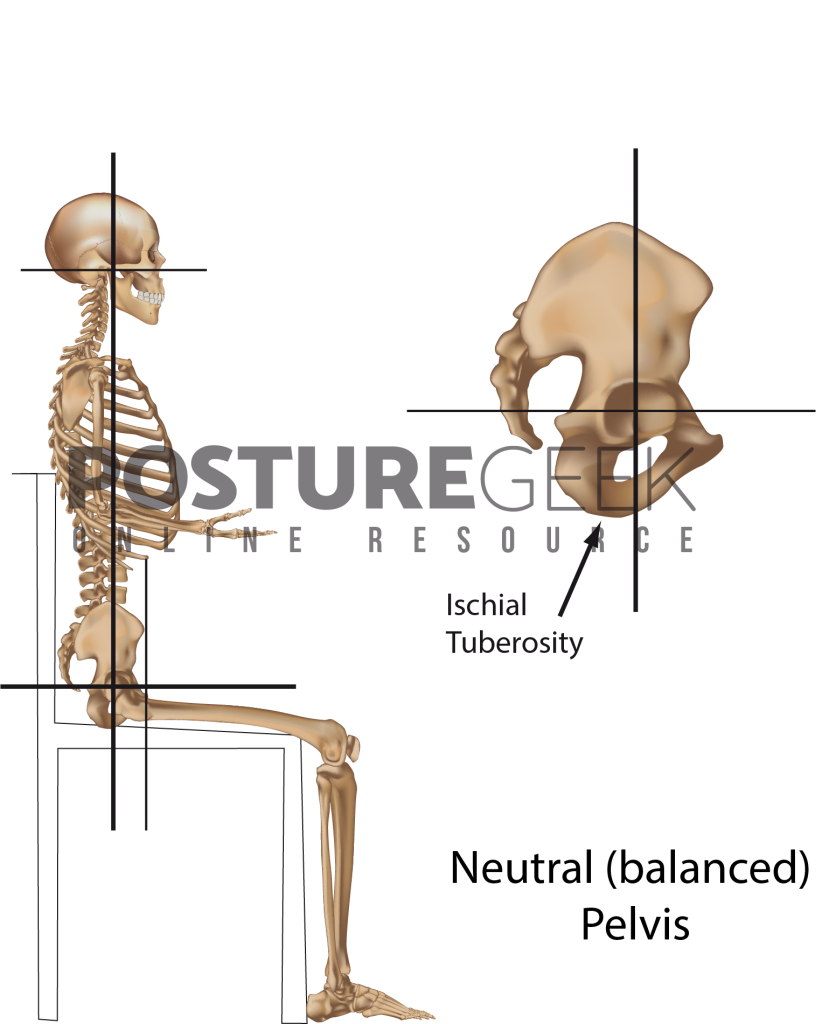Correct Sitting Posture
Creating the right environment for you to sit correctly
Developing strategies to find correct sitting posture is a great way to improve your posture. Below we dive into an exercise that will assist you on your journey for better posture. For example sitting at your desk or workstation. Take some time to play with the ideas discussed. Use this as a starting point.

EXERCISE
Searching for a Neutral Sitting Posture
Find somewhere to sit with a reasonably firm surface.
- Place the palms of your hands on your buttock, with the same hand on the same side (just where the top of the leg meets the buttocks) – this means right hand on the right IT and left hand on the left IT. Feel for that bony bit of your buttock on each side. These are your Ischial Tuberosities – we will call them your ‘IT’. Have you ever had someone sit on your lap and felt this bony part of their ‘butt’ sticking painfully into your thigh? If you have, you have made first contact with an IT – what we commonly call the ‘sitz’ bones. As the name implies, the ‘sitz’ bones are what we sit on.
- Now, tilt (rock) your pelvis (hips) forward and backward until you find that your IT’s are directly under your fingers. Feel it? This is you sitting on your ‘sitz’ bones.
- The lower back (lumbar spine) has a gentle, natural curve. This is what we are looking for when we are sitting with a neutral pelvis. You can search for the curve by either observing yourself in a mirror or feeling for it with your hand.
- Notice what you have to do with the tilt of your pelvis to help you find this position. It may mean that you have to move just a little forward of directly sitting on the IT to find a neutral pelvis.
- Bring your feet in line with your knees and your knees in line with your pelvis.
Make sure that your hips are slightly above the thigh line to offer a slight downward angle. Research suggests that this may play a reason in how easily we can sit in a comfortable position. Sitting with a slightly curved lower back may become easier if our hips are higher than our knees.
(Claus, A.P., Hides, J.A., Moseley, G.L., Hodges, P.W., Is ‘ideal’ sitting posture real?: Measurement of spinal curves in four sitting postures, Manual Therapy 14(2009) 404-408)
Exercise Considerations
Ischial Tuberosities (Sitz bones)
Make sure that you are not sitting too far back on these points. Avoid the inclination to sit all the way back so that the sacrum and coccyx (tail bone) are resting on the seat. Rolling under will have the effect of limiting the amount of lift and easy carriage that we can create above.
Remember the degree of support from below will dictate what is possible above.
Chest and Sternum
Notice what the Sternum (Breast Bone) is doing when you move or rock your pelvis forward on the Ischial Tuberosities. Does the Sternum feel as though it’s moving upwards and forward?
Play with this movement going backward and forwards and again notice how the pelvis influences the chest, shoulders, neck, and head.
Remember the degree of support from below will dictate what is possible above.
Shoulders
While the chest is opening through the Sternum, the shoulders gently ease downwards along the back; the shoulder blades (Scapula) slide downwards as if melting away. Think of ‘melting wax’ running down a candle.
Head
When we begin to find a stable base of support, the head will move along with the upward momentum generated by the placement of the hips. Now, imagine a helium balloon attached to the crown of the head. The balloon gently invites you to come away with it, lifting your head ‘effortlessly’ upwards— the attached muscles and ligaments the only thing reminding you of where you belong.
Hand Placement
As long as the basic movements of the main supporting structures are understood, the hands can be placed wherever is comfortable or required. However, make sure to not overextend your reach, making it difficult to maintain balance, stability, and support throughout.
PLEASE NOTE
The information provided should not replace the advice and expertise of an accredited health care provider. Any inquiry into posture care and any potential impact on your health and wellbeing should be directed to your health care provider.
